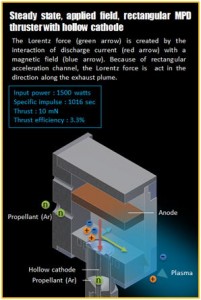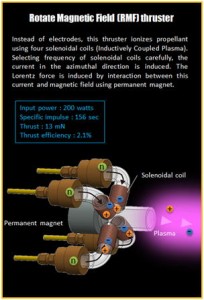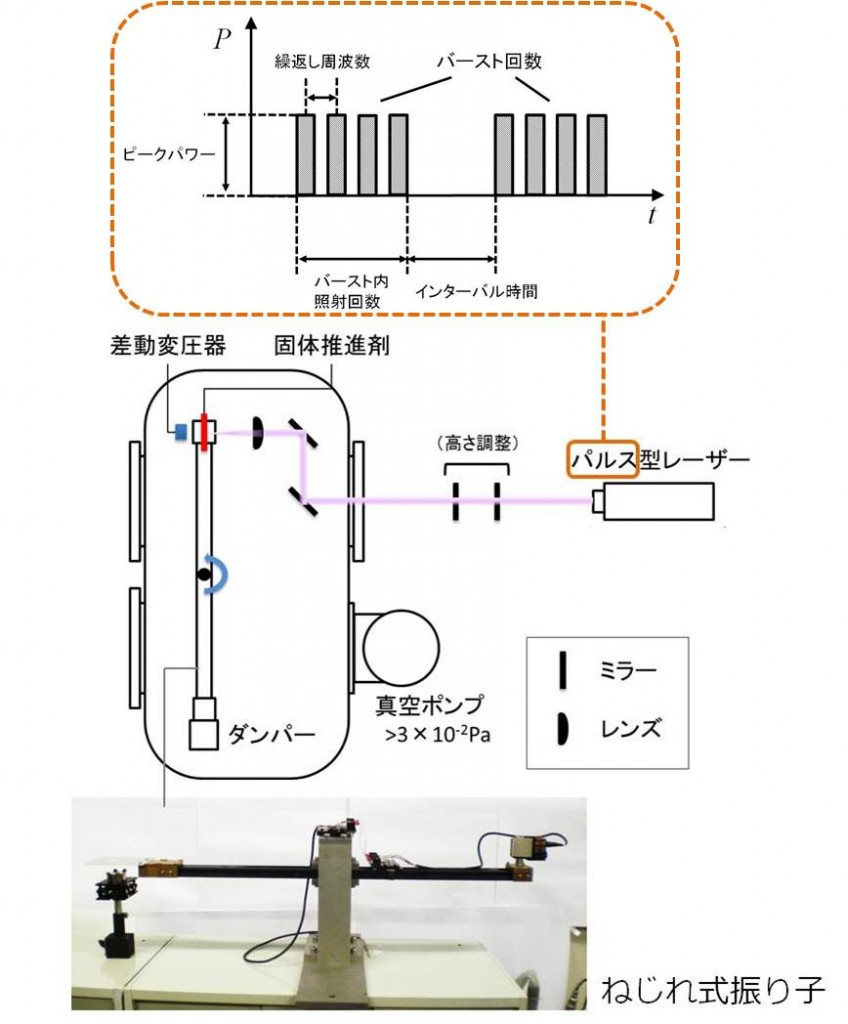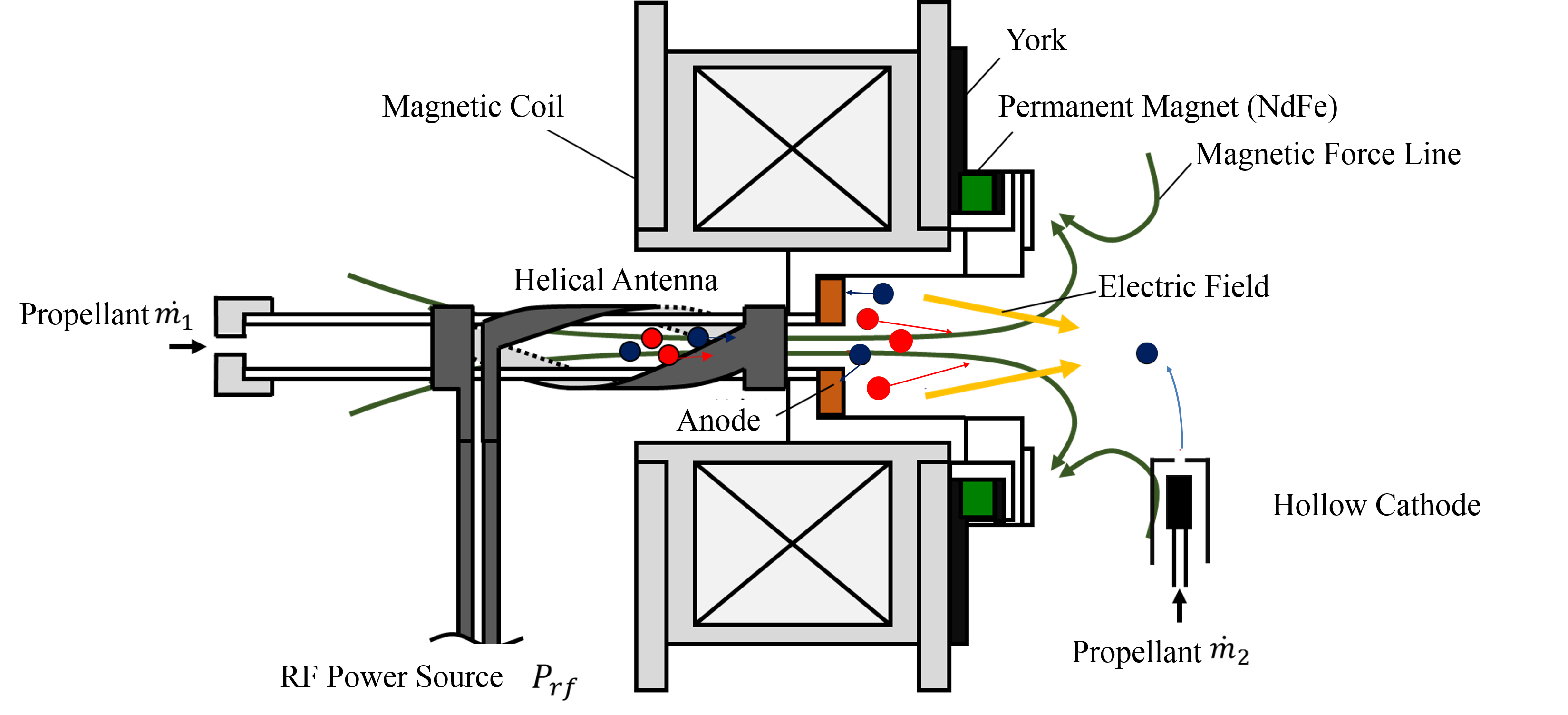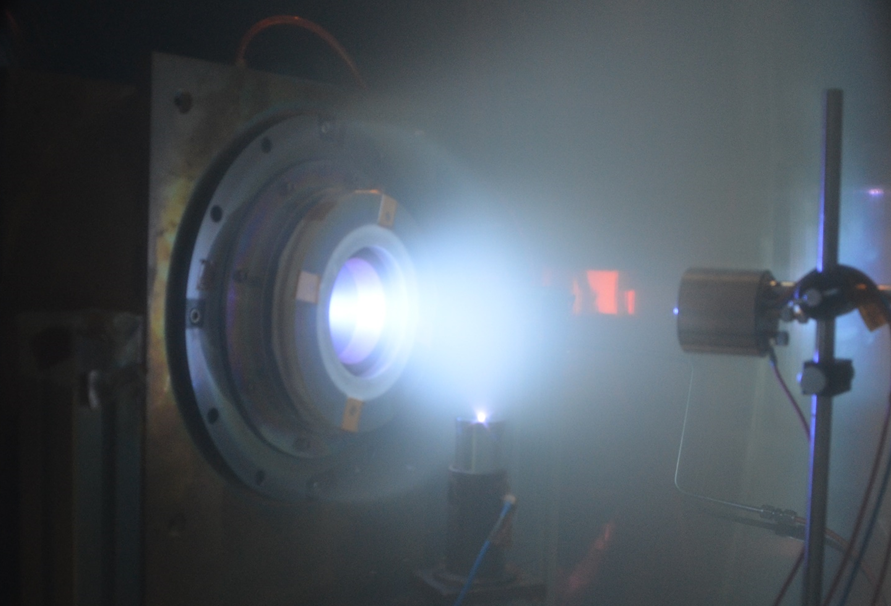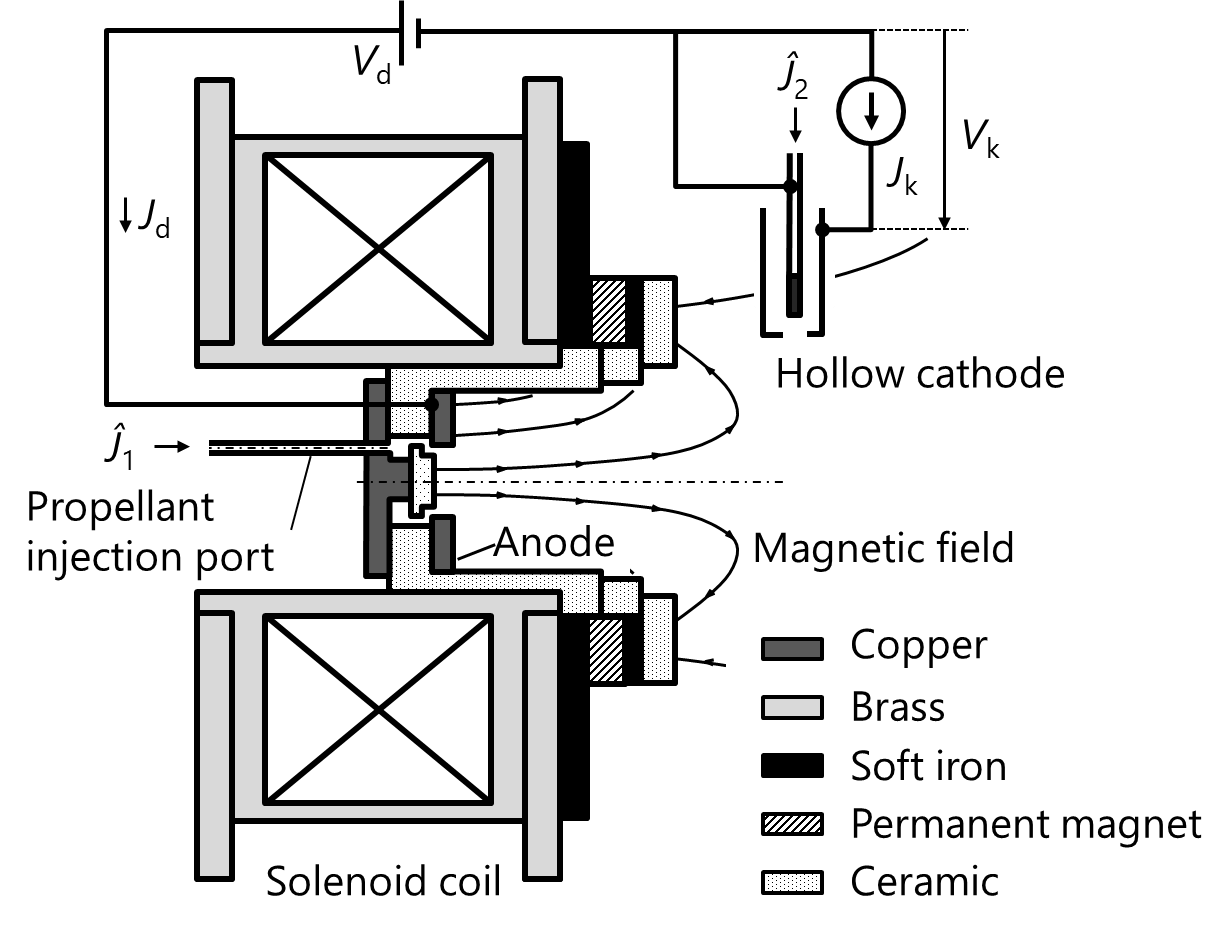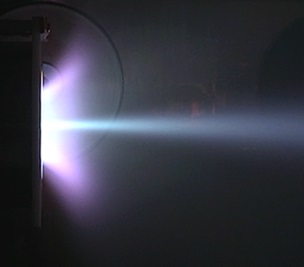MPD Thruster
About
Propellant consumption rate of rocket is determined by its exhaust velocity.
Deep space explorations or future space transport missions require the high exhaust velocity, and it can not be achieved by chemical fuel combustion energy. For these missions, it is necessary to use “Electric Propulsion” which can use electric energy.
Our laboratory intend to develop the electric propulsion technology with high efficiency and high exhaust velocity using high power.
The Advantage of Electric Propulsion

Fig.1 Chemical propulsion and Electric Propulsion
The main purpose of rocket engine is to accelerate the rocket by propellant injection and achieve the intended velocity. The requirement of velocity increment DV depends on the missions.
Electric propulsion enables high exhaust velocity so that it is use for missions required high DV. These engines are able to get high DV with small propellant consumption. In other words, the rate of burden (payload) is increased. (Fig. 1)
Furthermore, in the missions required extremely high DV such as deep space exploration, it is impossible to get to the destination by chemical propulsion. Ion thruster used for asteroid probe “Hayabusa” returned from Itokawa asteroid in 2010, is one of the electric propulsion systems.
Usefulness of MPD Thruster
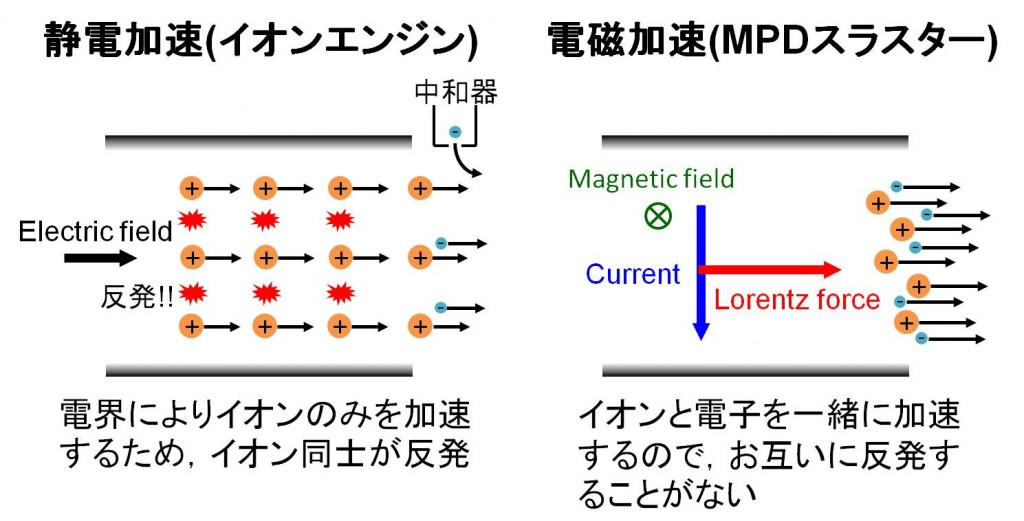
Fig.2 Difference of Ion thruster and MPD thruster
In the electric propulsion systems, the propellant is heated electro thermally, or ionized and accelerated by electric field or magnetic field. Ion thruster can accelerate only ions by Coulomb force in electrostatic field, but it has a limit of current caused by the mutual repulsion of ions.
Therefore, it can’t increase its thrust density. On the other hand, MPD thruster can accelerate both ions and electrons by Lorentz force in the electromagnetic field, so that it can get large thrust density without repulsion. And more, MPD thruster has features compared to other electric propulsion,
- It has simple configuration
- Various propellant gases can be used
- Improvement of thrust is expected when it is applied high-power
For these reasons, MPD thruster is one of the promising candidates for future high-power electric propulsion systems.
Current outcome
Laser Propulsion
About
Laser ablation propulsion is a next generation spacecraft propulsion method. Thrust is generated by beaming laser to propellant from a distant position.
Our study had investigated thrust generation law by using a high speed camera and had demonstrated an original launch method.
Currently, the focus is on impulse characteristics of repetition pulse irradiation as repetitive irradiation is expected to be needed in practical use.
Laser Propulsion
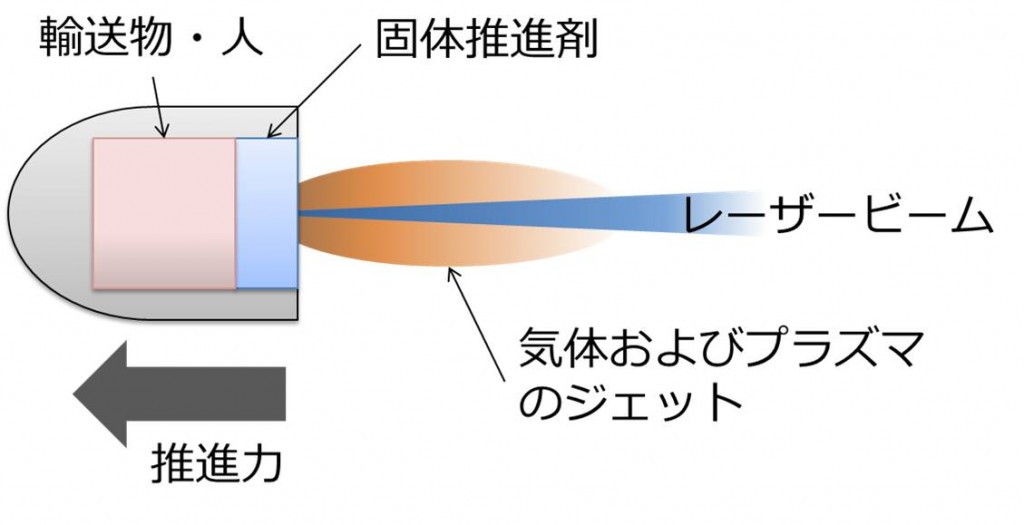
Fig.1 Principle of Laser Propulsion
Laser ablation is a phenomenon that a solid material is changed to gas or plasma by laser irradiation. Laser ablation propulsion is a next generation propulsion method using the ablation jet as thrust (Fig. 1). Since energy is partly supplied by laser beaming from a distant position, there is a possibility of reducing loaded propellant. Because of these merits it has, laser propulsion is expected to be applied to space debris re-orbiting and attitude control of satellite.
Theory of thrust generation
Laser ablation is a phenomenon that a solid material is changed to gas or plasma by laser irradiation. Momentum generation theory has been investigated by nanosecond scale visualization using a high speed camera (fig. 2). As a result, thrust generation theory has been verified. This is a theory that ablation is generated just after absorption of laser light and successive impulse is generated by expansion. In addition, a lot of phenomenons have been unveiled. For example, laser energy efficiency is decreased in atmosphere by plasma shielding.

Fig.2 Schlieren Image(TEO CO2 Laser,polyacetal,1000kfps)
How to launch without mounted fuel
How to get large thrust from limited energy source
The relation between laser irradiation method and impulse has yet to be clear. Therefore, laser is irradiated in various pulse conditions and impulse generated in these experiments are investigated(fig. 4). Heretofore, original impulse balance was developed in order to take accurate measurement of impulse generated by repeated irradiation of pulsed laser. This impulse balance is displaced by ablation when laser beam is irradiated to the target installed on the edge of the impulse balance. As long as impulse balance would not surpass quarter period, total impulse is able to be measured.
Helicon Electrostatic Thruster
About
Electric propulsion is the propulsion method that is expected for in future manned Mars exploration, farther space exploration, and so on. To use that way, the electric propulsion is needed to become a greater thrust, higher specific impulse, and higher efficiency thruster. In our study, We pay attention to a thruster using the helicon plasma as a large power thruster and push forward a study.
Helicon Plasma
Helicon plasma is the plasma that is made by a magnetic field and a high frequency electric discharge, and higher plasma density than like plasma made by high frequency discharge (e.g. Electron cyclotron resonant plasma(ECR), Inductively coupled plasma (ICP)). This plasma is regarded as the likely plasma source of high power electric propulsion.
| Plasma source | Frequency range | Plasma density [m³] |
| ECR | GHz | 1017 ~ 1019 |
| ICP | MHz (RF) |
~ 1019 |
| Helicon | 1019 ~ |
TABLE1. The Comparison of Other High Frequency Plasma
Fig1. Helicon Plasma (Argon)
Helicon Electrostatic Thruster (HEST)
It is Helicon Electrostatic Thruster(HEST) which is the new acceleration method for Electric thruster which is proposed in Nagoya University to emit the above-mentioned helicon plasma using the accelerator of the shape such as figure 2.
In this way, an electric field between the anode and the cathode is maintained by using the cusp magnetic field and accelerates the ion. After measuring the ion energy in the plume, I confirmed generation of the ion energy of 280eV in RF power 1,500W, acceleration voltage 300V. This was equivalent to 93% of acceleration voltage, and the effectiveness of the electrostatic acceleration was confirmed.
We are aiming at the performance enhancement of the thruster by elucidation of the acceleration mechanism and optimizing the thruster.
Fig2. HEST Overview
Fig3. HEST Operating Picture
Related Journal
- S.Harada, T.Baba, A.Uchigashima, S.yokota, A.Iwakawa, A.Sasoh, T.Yamazaki, and H.Shimizu, Applied Physics Letters, Vol. 105, ArtID 194101, 2014.
- A. Uchigashima, T. Baba, D. Ichihara, A. Iwakawa, A. Sasoh, T. Yamazaki, S. Harada, M. Sasahara, T. Iwasaki, IEEE Transactions on Plasma Science, Vol. PP(99), pp. 1-8,
Electrostatic Thruster (DM-EST)
About
It is an electrostatic thruster derived from HEST. DM-EST is an acronym for Diverging magnetic field electrostatic thruster. By using the same divergent magnetic field as HEST, by placing the cathode in the downstream magnetic free region, assuming that the magnetic force lines are equipotential surfaces, a radially inward electric field is created in the center of the anode. By utilizing this electric field, the propellant is ionized near the anode and accelerated toward the downstream. We believe that it is possible to reduce the weight by a simple magnetic circuit compared to the Hall thruster and that it can provide the merit in terms of cost by using inexpensive argon compared to xenon as the propellant.
Fig5.DM-EST Operating Picture
関連論文
- D. Ichihara, A. Uchigashima, A. Iwakawa, A. Sasoh, “Electrostatic ion acceleration across a diverging magnetic field”, AIP Applied Physics Letters 2016, Vol.109, Number 5
- Daisuke Ichihara, Akira Iwakawa, and Akihiro Sasoh. “Effects of magnetic field profile near anode on ion acceleration characteristics of a diverging magnetic field electrostatic thruster”, Journal of Applied Physics 122, 043302 (2017)
Electrostatic Thruster (CC-EST)
About
We tried to ionize and accelerate the propellant efficiently by making use of the fact that the anode center becomes the cathode potential in DM – EST, but the same effect can be obtained even if the cathode is arranged at the center of the anode. Then, CC – EST is invented. “CC” in CC-EST means Center Cathode. It has been experimentally confirmed that this thruster has both characteristics of electromagnetic acceleration and electrostatic acceleration. Our research is under way to improve the performance of this thruster and elucidation of physical phenomena of plasma.
Fig6.CC-EST Overview
Fig5.CC-EST Operating Picture
関連論文
- Akihiro Sasoh, Keisuke Mizutani, and Akira Iwakawa. “Electrostatic/magnetic ion acceleration through a slowly diverging magnetic nozzle between a ring anode and an on-axis hollow cathode”, AIP Advances(2017)







